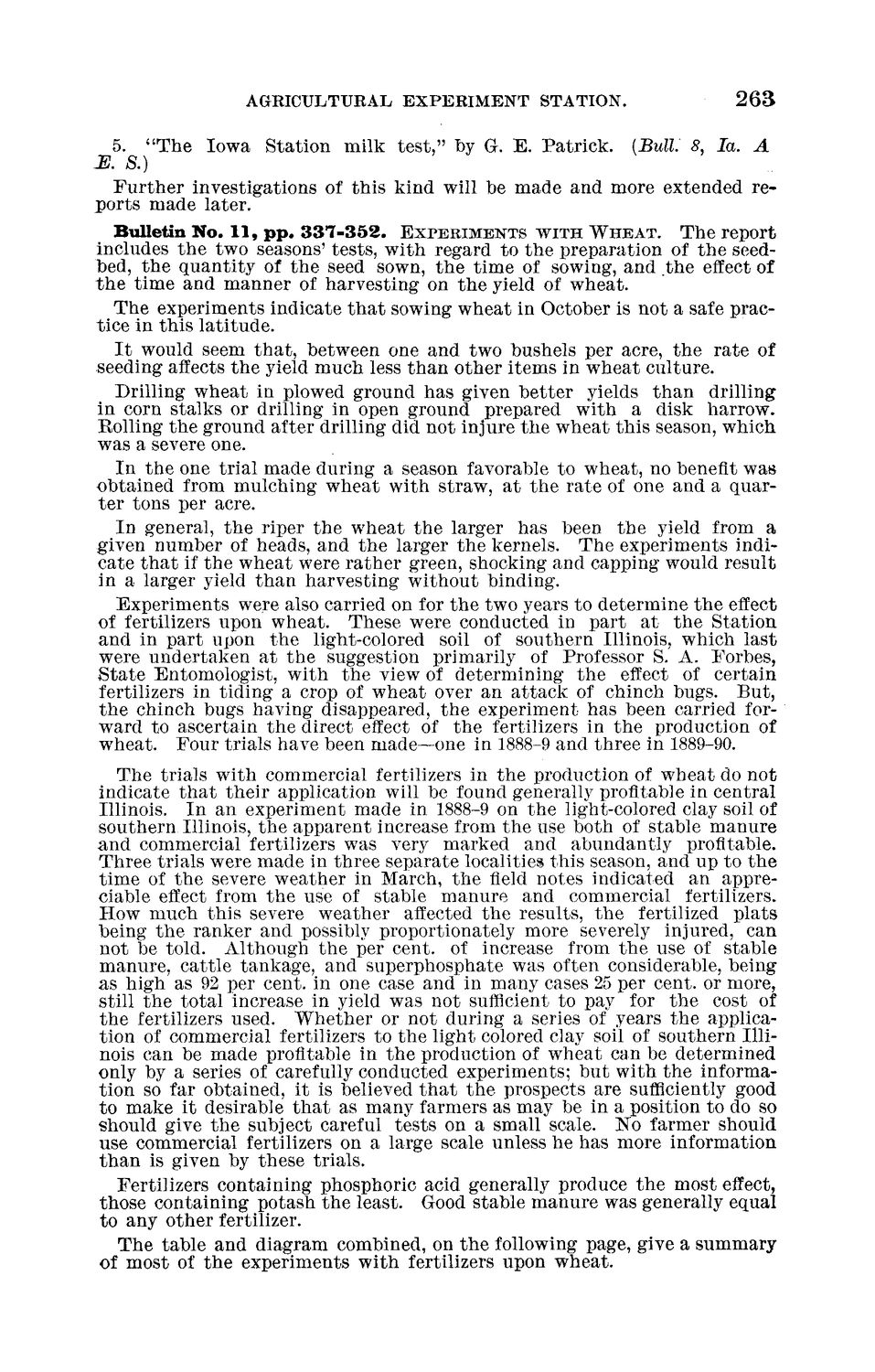| |
| |
Caption: Board of Trustees Minutes - 1890
This is a reduced-resolution page image for fast online browsing.

EXTRACTED TEXT FROM PAGE:
AGRICULTURAL EXPERIMENT STATION. 263 5. " T h e Iowa Station milk test," by G. E. Patrick. (Bull: 8, la. A B. S.) Further investigations of this kind will be made and more extended reports made later. Bulletin No. 1 1 , p p . 3 3 7 - 3 5 3 . E X P E R I M E N T S W I T H W H E A T . T h e report includes t h e two seasons' tests, with regard to t h e preparation of t h e seedbed, t h e quantity of t h e seed sown, t h e time of sowing, and .the effect of t h e time and manner of harvesting on the yield of wheat. The experiments indicate t h a t sowing wheat in October is not a safe practice in this latitude. I t would seem that, between one and two bushels per acre, t h e rate of seeding affects the yield much less than other items in wheat culture. Drilling wheat in plowed ground has given better yields than drilling in corn stalks or drilling in open ground prepared with a disk harrow. Boiling the ground after drilling did not injure the wheat this season, which was a severe one. In the one trial made during a season favorable to wheat, no benefit was obtained from mulching wheat with straw, at t h e rate of one and a quarter tons per acre. In general, t h e riper t h e wheat t h e larger has been t h e yield from a given number of heads, and t h e larger the kernels. The experiments indicate t h a t if the wheat were rather green, shocking and capping would result in a larger yield than harvesting without binding. Experiments were also carried on for the two years to determine the effect of fertilizers upon wheat. These were conducted in part at t h e Station and in part upon t h e light-colored soil of southern Illinois, which last were undertaken a t t h e suggestion primarily of Professor S. A. Forbes, State Entomologist, with t h e view of determining t h e effect of certain fertilizers in tiding a crop of wheat over an attack of chinch bugs. But, the chinch bugs having disappeared, t h e experiment has been carried forward to ascertain the direct effect of t h e fertilizers in t h e production of wheat. Four trials have been made—one in 1888-9 and three in 1889-90. The trials with commercial fertilizers in t h e production of wheat do not indicate t h a t their application will be found generally profitable in central Illinois. I n an experiment made in 1888-9 on t h e light-colored clay soil of southern Illinois, the apparent increase from the use both of stable manure and commercial fertilizers was very marked and abundantly profitable. Three trials were made in three separate localities this season, and up to t h e time of t h e severe weather in March, the field notes indicated an appreciable effect from t h e use of stable manure and commercial fertilizers. How much this severe weather affected t h e results, t h e fertilized plats being t h e ranker and possibly proportionately more severely injured, can not be told. Although the per cent, of increase from t h e use of stable manure, cattle tankage, and superphosphate was often considerable, being as high as 92 per cent, in one case and in many cases 25 per cent, or more, still t h e total increase in yield was not sufficient to pay for t h e cost of the fertilizers used. Whether or not during a series of years t h e application of commercial fertilizers to the light colored clay soil of southern Illinois can be made profitable in the production of wheat can be determined only by a series of carefully conducted experiments; but with the information so far obtained, it is believed t h a t t h e prospects are sufficiently good to make it desirable t h a t as many farmers as may be in a position to do so should give t h e subject careful tests on a small scale. No farmer should use commercial fertilizers on a large scale unless he has more information than is given by these trials. Fertilizers containing phosphoric acid generally produce t h e most effect, those containing potash the least. Good stable manure was generally equal to any other fertilizer. The table and diagram combined, on the following page, give a summary of most of t h e experiments with fertilizers upon wheat.
| |